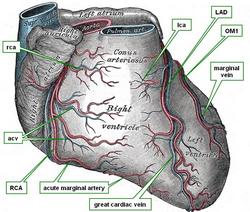The conal artery is the first anterior branch that arises from the right coronary artery. It can be double or multiple and it provides blood supply to the superior aspect of the conus arteriosus region (outflow tract) of the right ventricle. It is also known as the “conus artery”, and the “infundibular artery”. In about 50% of the cases the conal artery arises separately from the aorta, very close to the ostium of the right coronary artery. In this case the artery has been dubbed the “third coronary”.
In many cases, a secondary conal artery arises from the anterior interventricular (LAD) artery and is called the “left conal artery”. In some cases this left conal artery can be the only one present and there may be no “right” conal artery. When both conal arteries are present, in some cases and evident superficial anastomosis can be seen forming what is known as the “conal ring” or the “ring of Vieussens”, one of the few cases where there is actual collateral circulation between the right and the left coronary arteries.
Sources:
1. “The clinical anatomy of the conal artery” Loukas, M el al. J Clin Anat 2014 DOI: 10.1002/ca.22469
2. “The Clinical Anatomy of the Coronary Collateral Circulation: Loukas, M, et al J Clin Anat (2009) 22:146–160
3. “The Normal and Abnormal Anatomy of the Coronary Arteries” Loukas, M et al J Clin Anat (2009) 22:114–128
4 "Tratado de Anatomia Humana" Testut et Latarjet 8 Ed. 1931 Salvat Editores, Spain
5. "Anatomy of the Human Body" Henry Gray 1918. Philadelphia: Lea & Febiger
Image modified by CAA, Inc, Original image courtesy of bartleby.com




